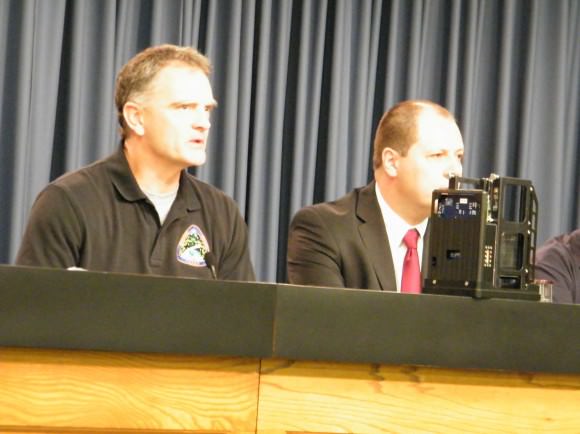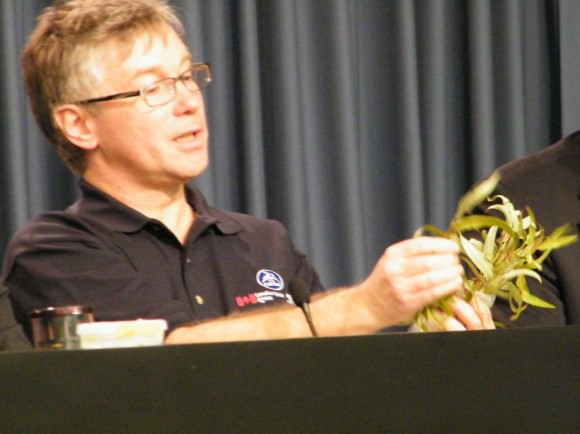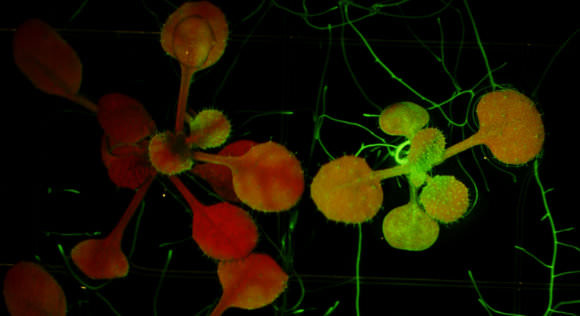“Melt from Alaskan glaciers largely overestimated in previous studies, glaciologists show (Science Daily)” plus 2 more |
- Melt from Alaskan glaciers largely overestimated in previous studies, glaciologists show (Science Daily)
- Glowing Plants Helps Biological Studies on ISS (Universe Today)
- PAREXEL International Corp. Reports Operating Results (10-Q) (Guru Focus)
| Posted: 05 Feb 2010 10:28 AM PST Message from fivefilters.org: If you can, please donate to the full-text RSS service so we can continue developing it. ScienceDaily (Feb. 5, 2010) — Glaciologists at the Laboratory for Space Studies in Geophysics and Oceanography (LEGOS -- CNRS/CNES/IRD/Université Toulouse 3) and their US and Canadian colleagues (1) have shown that previous studies have largely overestimated mass loss from Alaskan glaciers over the past 40 years. Recent data from the SPOT 5 and ASTER satellites have enabled researchers to extensively map mass loss in these glaciers, which contributed 0.12 mm/year to sea-level rise between 1962 and 2006, rather than 0.17 mm/year as previously estimated. Mountain glaciers cover between 500 000 and 600 000 km2 of the Earth's surface (around the size of France), which is little compared to the area of the Greenland (1.6 million km2) and Antarctic (12.3 million km2) ice sheets. Despite their small size, mountain glaciers have played a major role in recent sea-level rise due to their rapid melting in response to global climate warming. Of all the ice-covered regions of the planet, ice loss has been the greatest in Alaska and northwestern Canada, where glaciers cover 90 000 km2. Results from the LEGOS glaciologists and their US and Canadian colleagues, published in the February issue of Nature Geoscience, lead them to conclude that these glaciers have contributed 0.12 mm/year to sea-level rise over the period 1962-2006, rather than 0.17 mm/year as previously estimated by a team at the Geophysical Institute at the University of Alaska (Fairbanks). The new estimate was obtained by comparing recent topographies, derived from Spot 5-HRS (SPIRIT project (2) funded by CNES) and ASTER (GLIMS/NASA project), with maps from the 1950-60s, which enabled loss from three quarters of the Alaskan glaciers to be measured. How did the team from the Geophysical Institute of the University of Alaska estimate that the contribution of these glaciers to sea-level rise was 0.17 mm/year? In 1995, and then again in 2001, the researchers used an airborne laser to measure the surface elevation of 67 glaciers along longitudinal profiles. These elevations were then compared with those mapped in the 1950s and 1960s. From this, the researchers inferred elevation changes and then extrapolated this to other glaciers. Their results, published in Science (3), pointed to a major contribution to sea-level rise for the 1950-1995 period (0.14 mm/year sea-level rise), which then doubled in the recent period (after 1995). Why did they overestimate ice loss from these glaciers by 50%? The impact of rock debris that covers certain glacier tongues (4) and protects them from solar radiation (and thus from melting) was not taken into account in the previous work. Moreover, their sampling was limited to longitudinal profiles along the center of a few glaciers, which geometrically led to overestimation of ice loss. This new study confirms that the thinning of Alaskan glaciers is very uneven, and shows that it is difficult to sample such complex spatial variability on the basis of a few field measurements or altimetry profiles. Thanks to their regional coverage, satellite data make it possible to improve observations of glacial response to climate change and to specify the contribution of glaciers to sea-level rise. Ice loss from Alaskan glaciers since1962 is evidently smaller than previously thought. However, thinning (sometimes over 10 m/year, as in the Columbia glacier) and glacial retreat remain considerable. Moreover, the spectacular acceleration in mass loss since the mid 1990s, corresponding to a contribution of 0.25 to 0.30 mm/year to sea-level rise, is not in question and proves to be a worrying indication of future sea-level rise. Notes: (1) from Northern Arizona University (US) and two universities in Canada (University of British Columbia and University of Northern British Columbia). (2) During the 4th International Polar Year (2007-2009), the glaciologists had free access to SPOT 5-HRS data thanks to the SPIRIT project (SPOT 5 stereoscopic survey of Polar Ice: Reference Images and Topographies). The high-resolution images from this satellite can be used to reconstruct precisely the topography of polar ice and thus study its past and future evolution in response to climate fluctuations. LEGOS is the scientific coordinator for this project, which was carried out with CNES, Spot Image and IGN Espace. (3) Arendt et al, Rapid wastage of Alaska glaciers and their contribution to rising sea level. Science 297, 382-386 (2002) (4) The lower parts of a valley glacier. Story Source: Adapted from materials provided by CNRS. Journal Reference:
Note: If no author is given, the source is cited instead. Five Filters featured article: Chilcot Inquiry. Available tools: PDF Newspaper, Full Text RSS, Term Extraction. |
| Glowing Plants Helps Biological Studies on ISS (Universe Today) Posted: 05 Feb 2010 12:58 PM PST Message from fivefilters.org: If you can, please donate to the full-text RSS service so we can continue developing it. Written by Nancy Atkinson  Arabidopsis plants imaged in white light (left) and Green Fluorescent Protein (GFP) excitation illumination, right. Image provided by Anna-Lisa Paul, Ph.D. and Robert Ferl, Ph.D., Department of Horticultural Sciences, University of Florida. Glowing plants from space? Sounds like science fiction or the next B-horror movie. But glowing plants, willow trees, potential biofuels and more are being studied on the International Space Station and are part of key research in biotechnology, physiology, life sciences, and physical sciences going on in space. "This is not your grandfather's backyard garden," said Dr. Robert Ferl from the University of Florida, Gainesville." We are now understanding fundamental biological principals that essentially can only be studied when you leave the surface of the Earth." Scientists are abuzz this week with the newly proposed 2011 NASA budget which extends the life of the International Space Station to 2020, and perhaps beyond. "The possibility of an expanded budget for full utilization of the space station means that scientists can do the research and also the technology development that will fulfill the complete potential of ISS," said Julie Robinson, program scientists for ISS, "and that we will be able to bring back to Earth all the benefits that our new knowledge and technology can provide." At a press briefing today at Kennedy Space Center, a group of scientists shared current and future science investigations for the ISS, and the highlight was seeing some plants that actually glow in different colors to give scientists cues to what is taking place within the plant.  Robert Ferl at a press conference at KSC with a device from the APEX-TAGES experiment. Image: Nancy Atkinson The Advanced Plant EXperiments on Orbit – Transgenic Arabidopsis Gene Expression System (APEX-TAGES) investigation uses Arabidopsis thaliana, or thale cress that has genetically modified so it can glow. "Plants don't talk a lot," said Ferl, "so molecular biologists have been able to equip plants with the tools to have them communicate with us. Plants can glow with certain colors when certain genes are activated, when things happen like changes in their environments." APEX-TAGES uses a new real-time imaging system in conjunction with the "glowing" that removes the need for harvesting thereby allowing the plant to continue to grow and making it possible to follow the development of stress in a plant over time. The experiment also doesn't require a lot of time and interaction from the ISS crew, as digital images can be transmitted from the site of the experiment to the site of the researchers. "What are the limts to terrestrial biology? How far can it travel and explore?" said Ferl "50% of plant DNA is like ours, and 80% of plant genes are like ours. So plants can support us with food, air, and water revitalization, but they are interesting because by studying them we learn more about what happens to complex biology as it leaves the surface of the earth."  Perry Johnson-Green with the Canadian space agency displays the type of Willow trees grown in the ISS. Image: Nancy Atkinson Also highlighted at the briefing were studies of plant cell metabolism of a potential biofuel plant, Jatropha, and research done on the first trees ever grown on the space station, Canadian Cambium willow trees, that was sponsored by the Canadian Space Agency and performed on orbit by Canadian astronaut Robert Thirsk, who just returned from the ISS in November. Robinson also discussed an experiment on the ISS that found a better method of producing microencapsulated drugs for cancer and diabetes. A patent was issued at the end of 2009 and clinical trials are now being scheduled. With $50 million of the proposed budget going directly to ISS, as well as additional funds coming from the NASA's Science Directorate and technology development, Robinson said that scientists and technology developers will be fully utilizing the ISS as a National Lab in the coming years. For more info: Webpage of Dr. Werner Vendrame and his research with the Jatropha plant Webpage from the Canadian Space Agency on the willow trees grown on the ISS. Filed under: Science, Space Station Tags: ISS, ISS Science, ScienceRelated stories on Universe TodayFive Filters featured article: Chilcot Inquiry. Available tools: PDF Newspaper, Full Text RSS, Term Extraction. |
| PAREXEL International Corp. Reports Operating Results (10-Q) (Guru Focus) Posted: 05 Feb 2010 03:28 PM PST Message from fivefilters.org: If you can, please donate to the full-text RSS service so we can continue developing it. PAREXEL International Corp. (PRXL) filed Quarterly Report for the period ended 2009-12-31. Parexel International Corp. has a market cap of $1.1 billion; its shares were traded at around $18.98 with a P/E ratio of 22.8 and P/S ratio of 0.9. Parexel International Corp. had an annual average earning growth of 10.5% over the past 10 years. GuruFocus rated Parexel International Corp. the business predictability rank of 4-star. PRXL is in the portfolios of Edward Owens of Vanguard Health Care Fund, Chuck Royce of ROYCE & ASSOCIATES.Highlight of Business Operations:PCMS service revenue decreased by $2.2 million, or 6.9%, to $29.7 million for the three months ended December 31, 2009 from $31.9 million for the same period in 2008. The decline was caused primarily by a $1.2 million decrease in health policy and strategic reimbursement services, a $1.1 million decrease in consulting, and a $0.7 million decrease in other services, including the discontinuation of continuing medical education activities; partially offset by $0.8 million related to the positive impact of foreign exchange rate fluctuations. Perceptive service revenue decreased by $9.6 million, or 22.2%, to $33.4 million for the three months ended December 31, 2009 from $43.0 million for the three months ended December 31, 2008. The decrease was due primarily to a $9.2 million decrease in RTSM services and a $3.1 million decrease in CTMS services; partly offset by a $2.1 million increase in medical imaging and other services and $0.6 million related to the positive impact of foreign currency exchange rate fluctuations. Perceptive revenue for the three months ended December 31, 2008 included $7.6 million that was subsequently reversed in the fourth quarter of Fiscal Year 2009 due to an accounting adjustment related to start-up costs and deferred revenues. Perceptive direct costs decreased by $5.7 million, or 22.1%, to $20.1 million for the three months ended December 31, 2009 from $25.8 million for the three months ended December 31, 2008. The decrease was due to a $4.5 million decrease in the medical imaging business and a $2.1 million decrease in RTSM; partially offset by $0.3 million related to the negative impact of foreign exchange rate fluctuations and a $0.6 million increase in other service lines. Perceptive costs for the six months ended December 31, 2008 included $2.7 million that was subsequently reversed in the fourth quarter of Fiscal Year 2009 due to an accounting adjustment related to start-up costs. As a percentage of service revenue, Perceptive direct costs remained relatively flat for the three months ended December 31, 2009 compared with the three months ended December 31, 2008. We recorded net other expense of $9.9 million for the three months ended December 31, 2009 compared with net other income of $2.6 million for the three months ended December 31, 2008. The $12.6 million swing was attributable to a $13.6 million decrease in foreign exchange gains; partially offset by a $1.0 million decrease in interest expense (net of interest income). Miscellaneous expense for the three months ended December 31, 2009 included a $6.1 million reserve for an impaired investment in a French laboratory that filed for bankruptcy protection. Miscellaneous expense for the three months ended December 31, 2008 included a $3.0 million legal settlement charge related to a contract dispute and a $2.3 million write-off of certain impaired assets. On a segment basis, CRS service revenue increased by $20.1 million, or 5.0%, to $423.9 million for the six months ended December 31, 2009 from $403.8 million for the six months ended December 31, 2008. The increase was attributable to a $24.2 million increase in the Phases II-III/PACE portions of the business; partially offset by a $3.8 million decrease in the Early Phase business and $0.3 million related to the negative impact of foreign currency exchange rate fluctuations. Our growth in the Phases II-III/PACE business has been driven by the impact of strategic partnerships and an increase in demand in the Asia/Pacific region from both global studies and studies from local biopharmaceutical companies. The decrease in the Early Phase business was due to weakness in the first quarter of Fiscal Year 2010. Perceptive service revenue decreased by $11.1 million, or 15.1%, to $62.0 million for the six months ended December 31, 2009 from $73.1 million for the six months ended December 31, 2008. The decline was due primarily to a $9.8 million decrease in RTSM services, a $2.5 million decrease in CTMS, and the $1.7 million negative impact of foreign exchange rate fluctuations; partially offset by a 2.9 million increase in other service lines. Perceptive revenue for the six months ended December 31, 2008 included $13.3 million that was subsequently reversed in the fourth quarter of Fiscal Year 2009 related to an accounting adjustment on start-up costs and deferred revenu Five Filters featured article: Chilcot Inquiry. Available tools: PDF Newspaper, Full Text RSS, Term Extraction. |
| You are subscribed to email updates from Yahoo! News Search Results for International Studies To stop receiving these emails, you may unsubscribe now. | Email delivery powered by Google |
| Google Inc., 20 West Kinzie, Chicago IL USA 60610 | |



No comments:
Post a Comment